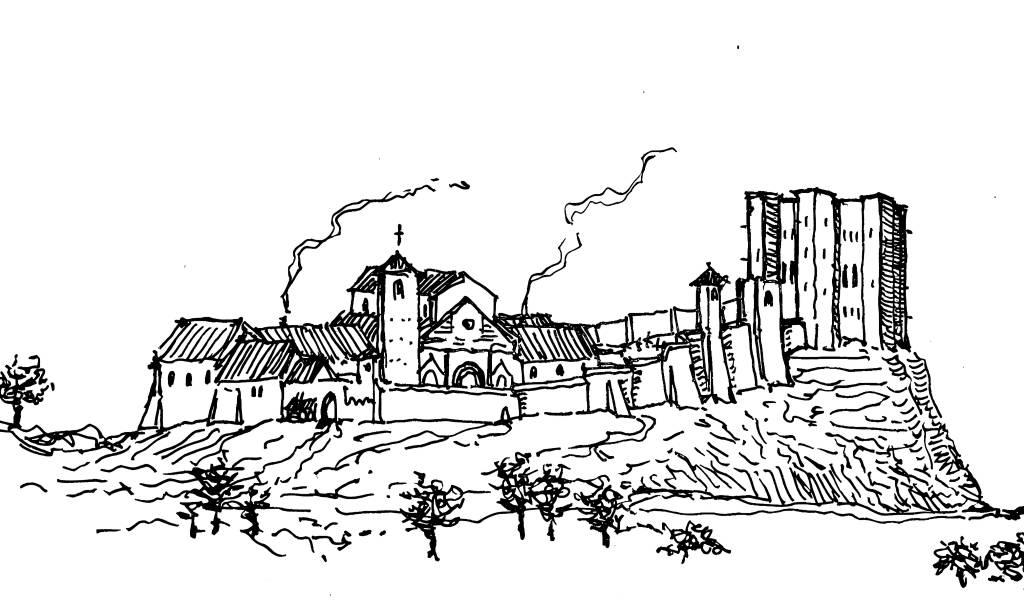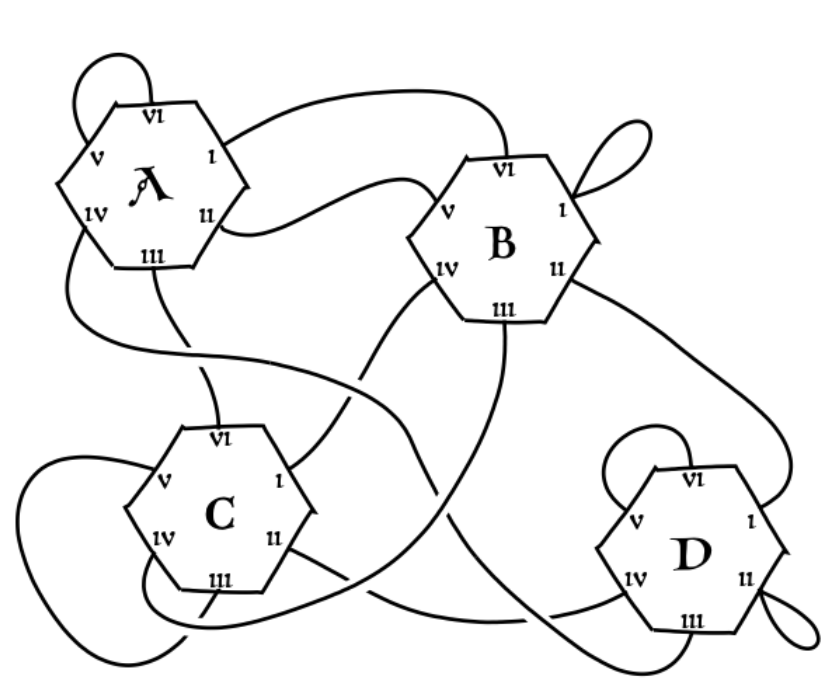
ICFP Programming Contest 2025
TASK DESCRIPTION
Contestants are tasked with constructing a map of a labyrinthine library by collecting information during repeated exploratory expeditions. This is version 1.2 — see the changelog on the task page.
BACKGROUND
In which our characters, Adso & William,
encounter the library at the Ædificium, and seek to uncover the secrets
therein.
 Adso of Milner and his master, William of
Backus, have at last arrived at the famed monastery of St. Kleene, under
the stewardship of the monks of the Holy Order of Evaluation, home of
the world-renowned Library of Lambdas, where it is said that all of the
world’s functions may be found.
Adso of Milner and his master, William of
Backus, have at last arrived at the famed monastery of St. Kleene, under
the stewardship of the monks of the Holy Order of Evaluation, home of
the world-renowned Library of Lambdas, where it is said that all of the
world’s functions may be found.
The library makes up the greatest part of the Ædificium: the large,
imposing, fortress-like building casting a long shadow over the
cloisters in the setting sun. It is closely guarded by the Abbot and his
librarian, Alonzo of Curry, so William and Adso can only gain access to
the library via skulduggery, sneaking into the Ædificium when the monks
and nuns are busy at the International Conference on Functional
Programming.
The Ædificium is huge, and only Alonzo and the Abbot know all of its
chambers and passages. Some even say that a curse lies on the library,
and that any who enter unbidden will never find their way out again.
William, a learned scholar of great intuition and logic, dismisses such
superstitions out of hand, steadfast in his determination to uncover the
secrets of the library. He exclaims in the fashion of his master,
Hilbert, “Wir müssen wissen, wir werden wissen!”
Adso, ever doubtful and unsure, inquires of his master, “How shall we
know where to go without the guidance of the librarian? We do not even
have a map!"
William, a devious glint behind his eyes, replies, “Well, my dear
Adso, we shall have to make one.”
THE ÆDIFICIUM
In which the structure of the Library is
described, as well as the nature of the task before William &
Adso.
The Ædificium is comprised of a number of
hexagonal rooms, each side of which has a door, labelled with a number
0–5. Through each door lies a passage to another room. The rooms
themselves are also labelled, but the label is in a language that Adso
cannot read. William understands the language, but with his failing
eyesight, he can only discern the first two bits of the label. More than
one room may have the same label. Passages may lead to the same room
from which they started — or even the same door.

An example of a 4-room Ædificium.
To avoid getting lost, Adso & William must devise a route
plan before entering the library. A route plan consists of a series
of numbers 0–5, indicating the sequence of doors through which they plan
to travel, starting from the initial room. The route plans always start
from the same room.
As they travel through the library according to their route plan,
Adso will record the 2-bit integers that William reads from the label of
each room. Thus, after executing a route plan of length x, Adso will have a record
consisting of x+1 2-bit
integers.
The task before Adso & William is to construct a series of route
plans such that they gain the information necessary to construct an
accurate map of the library, in the form of an undirected graph, using
as few expeditions into the library as possible.
PROTOCOL
In which the format of route plans and Adso’s
records are specified, as well as the representation of the
map.
Queries are made to the Ædificium by making an
HTTP request to the server at the URL:
POST /register registers a new team.
Request Body:
{
"name": string,
"pl": string,
"email": string
}
Response Body:
The id given in the response is secret
and used to identify your team in future requests. Remember it but do
not disclose it publicly!
POST /select selects a problem to solve.
Request Body:
{
"id": string,
"problemName": string,
}
Response Body:
{
"problemName": string
}
The id should be exactly the same string produced by
/register. The problemName may be any of the
available problems, the full list of which is available on the leaderboard
page. Each problem has a specified number of rooms, but the exact
layout of the map is randomly generated each time a problem is
selected.
For testing purposes, a simple three-room labyrinth, small enough to
be solvable by hand, may also be selected by using the problem name
"probatio".
Note if a problem is already selected, POSTing to
/select will discard the old problem and generate a new one
to solve.
POST /explore explores the ædificium.
Request Body:
{
"id": string,
"plans": [string],
}
Response Body:
{
"results": [[int]],
"queryCount": int
}
Only POST to /explore after selecting a problem with
/select.
The id should be exactly the same string produced by
/register. The plans field should consist of a
list of route plans, each represented as a string of digits
0–5, specifying the numbers of each door to
enter. For example, the string "0325" is the route plan
that first enters door 0, then 3, then
2, then 5.
The route plans are limited in length — Adso must make it out of the library by sunrise. They can enter at most 18n doorways per night, where n is the number of rooms in the library.
The results field consists of a list of Adso’s records,
one for each route plan submitted. Each record is a list of integer
values — the 2-bit integer values observed by William upon entering each
room. The queryCount field contains the total number of
expeditions made into the Ædificium so far. Remember, Adso and William
want to make as few expeditions into the library as possible, so guesses
made with a low queryCount will rank higher in the
leaderboards.
Note: We allow multiple route plans to
be submitted in a single HTTP request. This reduces our server costs, so
to incentivise contestants batching their route plans, an additional
one-point queryCount penalty applies per
/explore request made.
POST /guess submit a candidate map.
Request Body:
{
"id": string,
"map": {
"rooms": [int],
"startingRoom": int,
"connections": [
{
"from": {
"room": int,
"door": int
},
"to": {
"room": int,
"door": int
}
}
]
}
}
Response Body:
Only POST to /guess after selecting a problem with
/select.
The id should be exactly the same string produced by
/register. The map field contains a
description of the layout of the library. The rooms field
of this description is a list of the 2-bit integer labels read by
William, one per room. Rooms are identified by their index into this
list. The startingRoom field specifies the index of the
initial room. The connections field contains a list of
objects that specify how each room is connected, where the
room fields specify the index of a room and the
door field specifies a door number,
0–5. Note that the graph constructed is
undirected, so if one has already connected, say, from door
3 of room 5 to door 0 of room 2, there is no need to
connect from door 0 of room 2 to door 3 of
room 5 — this connection will already exist.
The field correct is true iff the submitted
map is equivalent to the map generated when
/select was invoked. By equivalent, we mean that
they have the same number of rooms, and that they are indistinguishable
by any route plan — if there is no route plan that demonstrates the
difference between two maps of the same size, they are considered
equivalent.
If a correct map is submitted, if the queryCount for
your team is an improvement on your previous score for the currently
selected problem, then your score is updated.
Regardless of if the submitted map is correct or not, the problem
will be deselected and the library cleared when /guess
is invoked. This means that, if your guess was incorrect, you will have
to start again on a new map with /select.
SCORING
In which the criteria by which entries are
evaluated are given, along with pointers to global scoreboards.
Grading of correct maps is based on the
efficiency with which they were produced: Specifically, the
amount of expeditions required to produce the graph.
Each team is ranked on the local leaderboard for each problem, with
the team that required the fewest expeditions to correctly generate the
map ranked first, and all teams that have not (yet) submitted a correct
solution to that problem ranked equal last.
The global
leaderboard is computed using the Borda count method, similar to
last year’s contest. For each problem, each team is given one point for
every other team that places strictly worse in the rankings. The team
that has the most points across all problems is ranked first in the
global leaderboard. An important property of this system is that
absolute scores for a problem do not matter — only the relative
order.
The leaderboards are updated every few minutes throughout most of the
contest, however they are temporarily frozen two hours before the end of
the lightning round and also in the last two hours of the contest, to
add to the suspense.
SUBMISSION
In which the method of participation and entry
submission is described, as well as the dates during which this is
available.
To be considered for prizes, your team must
submit their code. This is accomplished by the following Google form.
Include your id from /register and a URL at
which your code can be accessed (for example, a Git repository). Don’t
make your code public until after the contest.
This form closes 3 hours after the end of the contest. It is not
necessary to make a separate submission for the lightning round, but
please include a README file indicating which parts are from the first
24 hours.
Note that we also hand out a “jury prize”, so being on top of the
scoreboard is not required to win (but it is a recommended way of
winning).
 Adso of Milner and his master, William of
Backus, have at last arrived at the famed monastery of St. Kleene, under
the stewardship of the monks of the Holy Order of Evaluation, home of
the world-renowned Library of Lambdas, where it is said that all of the
world’s functions may be found.
Adso of Milner and his master, William of
Backus, have at last arrived at the famed monastery of St. Kleene, under
the stewardship of the monks of the Holy Order of Evaluation, home of
the world-renowned Library of Lambdas, where it is said that all of the
world’s functions may be found.

